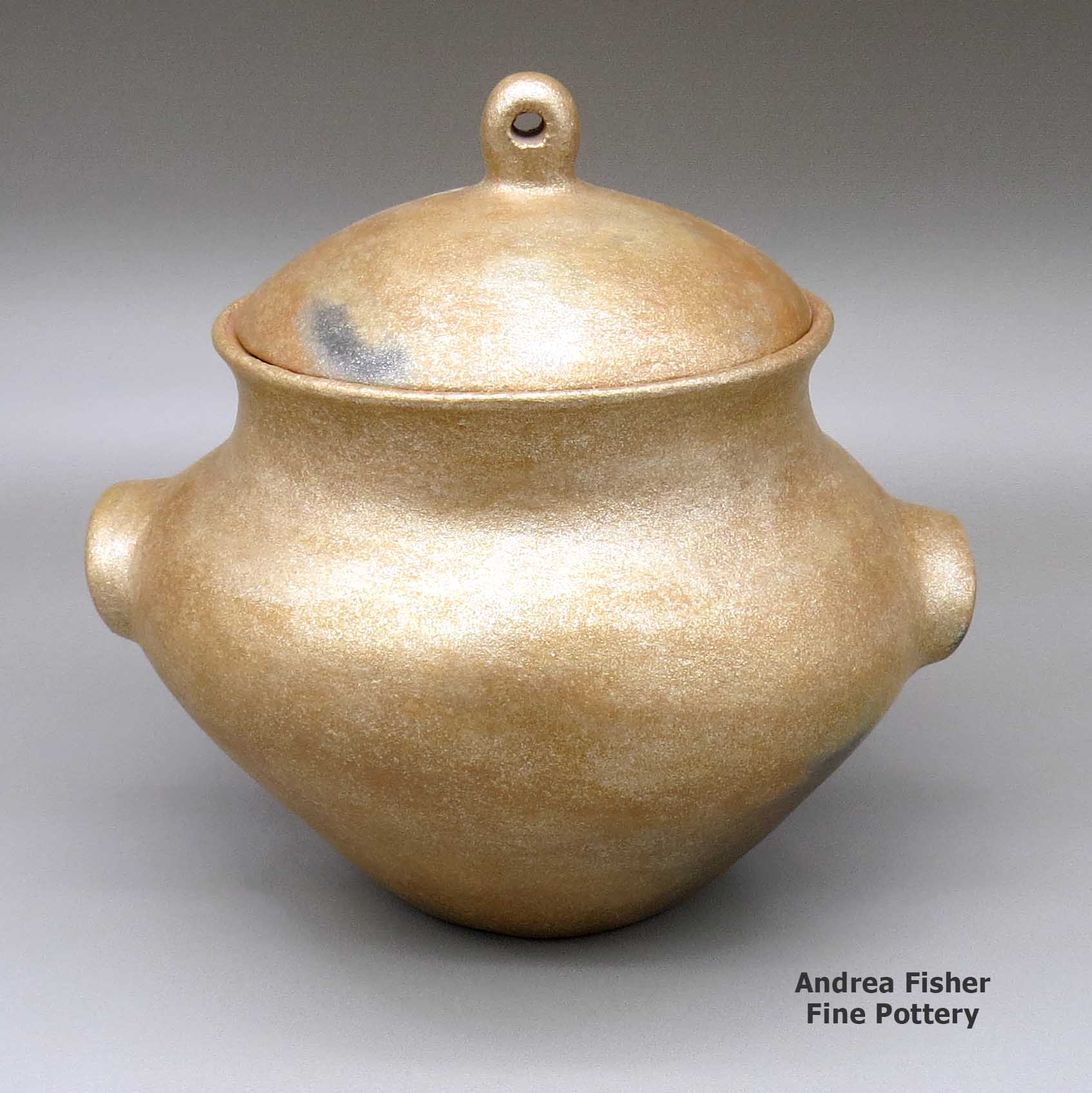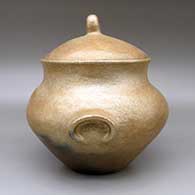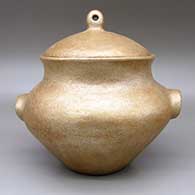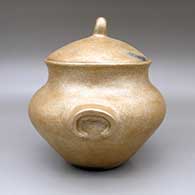(505) 986-1234 - www.andreafisherpottery.com - All Rights Reserved
Anthony Durand
Picuris
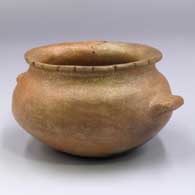
Anthony Durand was a potter from Picuris Pueblo. Born in 1956, he passed away in 2009. He learned the traditional Picuris way to make pottery from his grandmother, Cora Durand, beginning when he was 7 years old.
Traditional Picuris pottery is made with micaceous clay. Micaceous clay, when thick enough with flecks of mica, holds liquids. It can be cooked with and some folks say the best beans they ever had were cooked in a Picuris-made bean pot. The only embellishments on Picuris pottery were sculptural, too.
Cora made utilitarian Picuris pottery and that's what she taught Anthony to make.
Industrial mining activities at Picuris caused the potters to lose their traditional source of clay. Anthony searched and experimented and finally found a source that would replicate the color and lustre of ancient Picuris pots. After that he became an exhibitor at Santa Fe Indian Market and earned several ribbons for his work.
Anthony shared a booth with his grandmother at the 1995 Micaceous Pottery Artists Convocation at the School for American Research (now the School for Advanced Research).
Picuris
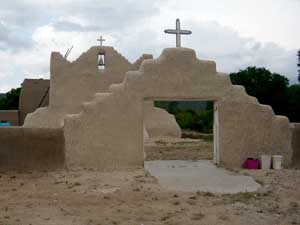
San Lorenzo de Picuris Mission
Picuris Pueblo was larger than Taos when the Spanish first arrived in northern New Mexico. About 200 years before, the Picuris had moved to a location about 25 miles southeast of Taos in a high mountain pass, most likely because of increased trading possibilities with the Utes, Comanche, Apaches and Kiowas who often ventured through the pass for raiding and trading purposes. It was that kind of traffic that had made Taos great and the Picuris leveraged their new location to become greater yet.
On first sight, Spanish explorer Don Juan de Oñaté referred to the village as the "Grande Pueblo de Picuris." Reports from other Spaniards who visited the area in the late 1500's claim the original pueblo structure was as much as nine stories tall with as many as 3,000 residents. Realistically, it was more like four or five stories high and housed maybe 1,500 inhabitants.
Back then Picuris was a large and relatively powerful pueblo. The Spanish arrival was a major threat to their power and lifestyle. Because of the central bloody role Picuris Pueblo played in the Pueblo Revolt of 1680, when the Spanish returned in 1692 they looted, burned and leveled the pueblo. The residents scattered, some to other pueblos, some to Cuartelejo on the plains of western Kansas. Eventually the people returned and began rebuilding in a new location around 1706. But the pueblo's spirit was broken and Picuris has never returned to its former glory.
In the center of today's Picuris Pueblo is the San Lorenzo Mission, built in the 1770's. Because of years of water damage, it was feared in the 1980's that the church would collapse soon. The building couldn't be saved and had to be torn down. Tribal members then spent the next eight years using traditional methods to rebuild the church on the existing foundation. The original Picuris pueblo site (the one destroyed by the Spanish) was excavated in the 1960's and is now a protected archaeological site.
Picuris and Taos Pueblos traditionally used a clay that is high in mica content to make their pottery. This micaceous clay creates a distinctive metallic luster that sets their pottery apart from virtually all other pueblo pottery. In addition, micaceous pots and bowls are the only pueblo pottery that can be put directly on a fire or stove for cooking purposes. The Tewa Pueblos to the south sometimes copied the Taos/Picuris style but they used different clays and tempers and achieved different results.
Taos and Picuris pottery is very similar. The main difference between them is that unpainted functional Picuris pots tend to be thinner than similar Taos pots. On some of their pots Picuris potters coat the pot with a slip of mica before it is fired. Often the fire clouds produced in the firing process are a pot's only decoration. Sometimes Picuris potters would add raised rope or inlaid beads or molded clay animals to their pots. They also produced an amount of striated pottery, the striations being achieved through various physical means.
In the old days, local Hispanic villagers often purchased Picuris functional pottery for household use. While the unpainted functional micaceous pottery has been in production since about 1600, it really dominated Picuris production after the Pueblo Revolt of 1680. In many ways the Picuris potters copied the plain pots of their new Apache neighbors (the Apaches arrived in the neighborhood about the same time as the Spanish). Picuris potters produced a fair amount of their traditional pottery styles until their primary source of micaceous clay was almost destroyed by an industrial mica-mining project. Loss of that clay source nearly ended the Picuris pottery tradition.
More recently Anthony Durand took on the job of trying to revive the Picuris pottery tradition after his grandmother led him to a new source of micaceous clay. Sadly, Anthony passed on in 2009. These days, many non-Picuris artists are also using micaceous clay to create beautifully shaped pots, figures and sculptures. Recently there has been a movement among the pueblo potters to create more aesthetic and artistic styles of pottery using micaceous clays. They hope this effort will create a market for their pottery as works of art rather than just functional utility ware.
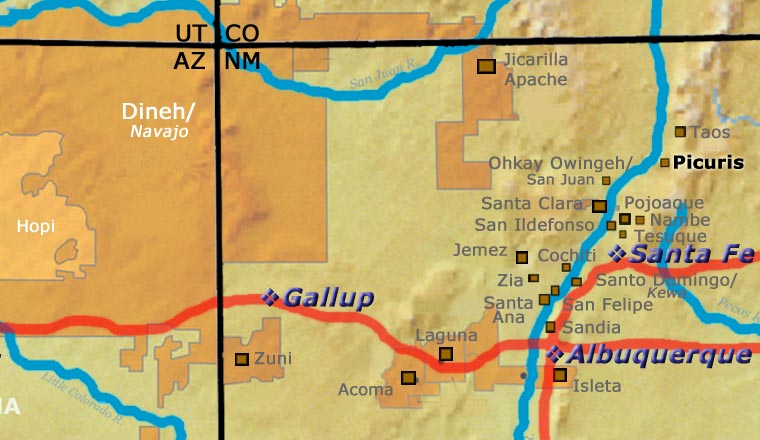
Picuris Pueblo at Wikipedia
Picuris Pueblo official website
Upper left photo courtesy of Wikipedia userid Davidhc9, CCA-by-SA 3.0 License
Micaceous Clay Pottery

Angie Yazzie
Taos
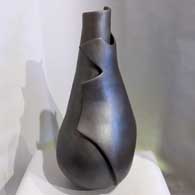
Christine McHorse
Navajo
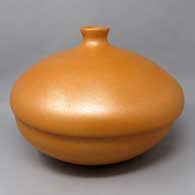
Clarence Cruz
San Juan/Ohkay Owingeh
Micaceous clay pots are the only truly functional Pueblo pottery still being made. Some special micaceous pots can be used directly on the stove or in the oven for cooking. Some are also excellent for food storage. Some people say the best beans and chili they ever tasted were cooked in a micaceous bean pot. Whether you use them for cooking or storage or as additions to your collection of fine art, micaceous clay pots are a beautiful result of centuries of Pueblo pottery making.
Between Taos and Picuris Pueblos is US Hill. Somewhere on US Hill is a mica mine that has been in use for centuries. Excavations of ancient ruins and historic homesteads across the Southwest have found utensils and cooking pots that were made of this clay hundreds of years ago.
Not long ago, though, the making of micaceous pottery was a dying art. There were a couple potters at Taos and at Picuris still making utilitarian pieces but that was it. Then Lonnie Vigil felt the call, returned to Nambe Pueblo from Washington DC and learned to make the pottery he became famous for. His success brought others into the micaceous art marketplace.
Micaceous pots have a beautiful shimmer that comes from the high mica content in the clay. Mica is a composite mineral of aluminum and/or magnesium and various silicates. The Pueblos were using large sheets of translucent mica to make windows prior to the Spaniards arriving. It was the Spanish who brought a technique for making glass. There are eight mica mining areas in northern New Mexico with 54 mines spread among them. Most micaceous clay used in the making of modern Pueblo pottery comes from several different mines near Taos Pueblo.
As we understand it, potters Robert Vigil and Clarence Cruz have said there are two basic kinds of micaceous clay that most potters use. The first kind is extremely micaceous with mica in thick sheets. While the clay and the mica it contains can be broken down to make pottery, that same clay has to be used to form the entire final product. It can be coiled and scraped but that final product will always be thicker, heavier and rougher on the surface. This is the preferred micaceous clay for making utilitarian pottery and utensils. It is essentially waterproof and conducts heat evenly.
The second kind is the preferred micaceous clay for most non-functional fine art pieces. It has less of a mica content with smaller embedded pieces of mica. It is more easily broken down by the potters and more easily made into a slip to cover a base made of other clay. Even as a slip, the mica serves to bond and strengthen everything it touches. The finished product can be thinner and have a smoother surface. As a slip, it can also be used to paint over other colors of clay for added effect. However, these micaceous pots may be a bit more water resistant than other Pueblo pottery but they are not utilitarian and will not survive utilitarian use.
While all micaceous clay from the area of Taos turns golden when fired, it can also be turned black by firing in an oxygen reduction atmosphere. Black fire clouds are also a common element on golden micaceous pottery.
Mica is a relatively common component of clay, it's just not as visible in most. Potters at Hopi, Zuni and Acoma have produced mica-flecked pottery in other colors using finely powdered mica flakes. Some potters at San Ildefonso, Santa Clara, Jemez and San Juan use micaceous slips to add sparkle to their pieces.
Potters from the Jicarilla Apache Nation collect their micaceous clay closer to home in the Jemez Mountains. The makeup of that clay is different and it fires to a less golden/orange color than does Taos clay. Some clay from the Picuris area fires less golden/orange, too. Christine McHorse, a Navajo potter who married into Taos Pueblo, uses various micaceous clays on her pieces depending on what the clay asks of her in the flow of her creating.
There is nothing in the makeup of a micaceous pot that would hinder a good sgraffito artist or light carver from doing her or his thing. There are some who have learned to successfully paint on a micaceous surface. The undecorated sparkly surface in concert with the beauty of simple shapes is a real testament to the artistry of the micaceous potter.
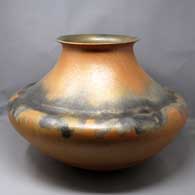
Lonnie Vigil
Nambe
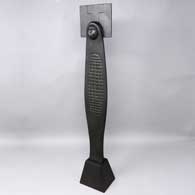
Robert Vigil
Nambe

Preston Duwyenie
Hopi
Copyright © 1998-2024 by


